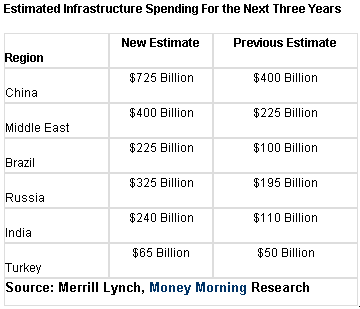In order to sustain economic growth, increases of infrastructure spending are critical for the emerging economies as their populations continue to expand and urbanize.
The developed world has a population of approximately 1 billion versus the developing world’s 5.5 billion people. As the emerging economies and the developing world keeps pushing to catch up, the continued economic growth in emerging markets (EM) have prompted a boom in infrastructure building.
In the past few years EM countries have benefited significantly from strong global growth
and the impressive rise in commodity prices. Consequently, many countries that had been running large current account and balance of payments deficits in the 1990s, are now running surpluses and have become significant creditors to the rest of the world. This transformation to profitability has allowed for the funding of infrastructure spending to deal with future needs as well as in some cases decades of accumulated backlogs.
Despite some current signs of a slowdown in emerging markets, (China’s expansion for instance, continued to moderate, with GDP growth slowing to a 10.1% annual rate in the 2Q’08 from the 1Q’s 10.6%) growth prospects – particularly for the BRICs (the acronym, standing for Brazil, Russia, India & China), remain inevitable and solid. If anything, most if not all BRIC countries currently seem to be at risk of overheating, but nothing more than that.
That’s why the governments and particularly, private sector players with increased accessibility in these markets, are deploying unprecedented amounts of capital to upgrade the emerging world. According to a research conducted by Morgan Stanley (MS), a total of US$21.7 trillion in infrastructure spending is projected to be spent across emerging markets over the next decade, with Asia representing 67% of this total. China is expected to make up the majority of the spending, claiming 43%, followed by India’s 13%. Other key EM countries and their share of spending are Russia with 10% and Brazil with 5%.
Private funding supporting one or more general subject area projects as well as innovative dedicated infrastructure funds – are heavily engaged. A surge in market listings of owners, operators and contractors to build emerging markets infrastructure assets, is also underway. According to estimates, the number of listed EM infrastructure-related entities, notes MS – has risen from 230 to 354 (54% increase) over the last five years—with total market cap increasing from $146 billion to $1.1 trillion.
Merrill Lynch (MER) also came out with a report, recently – where it raised its annual infrastructure-spending estimate for emerging markets by 80%, “with an implied run rate of $6.6 trillion over the next three years”.

One interesting fact, based on statistics – by the end of fiscal 2010, the economic output of the developing world will at least, equal if not surpass that of the developed world.
Disclaimer: This page contains affiliate links. If you choose to make a purchase after clicking a link, we may receive a commission at no additional cost to you. Thank you for your support!


Leave a Reply